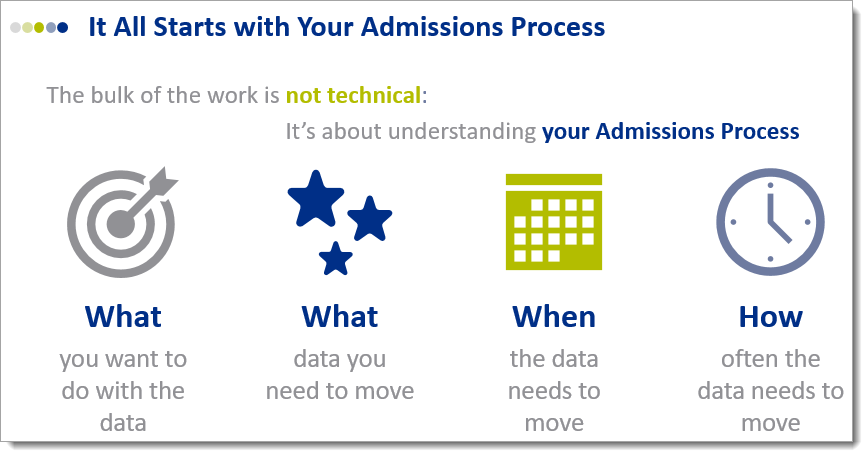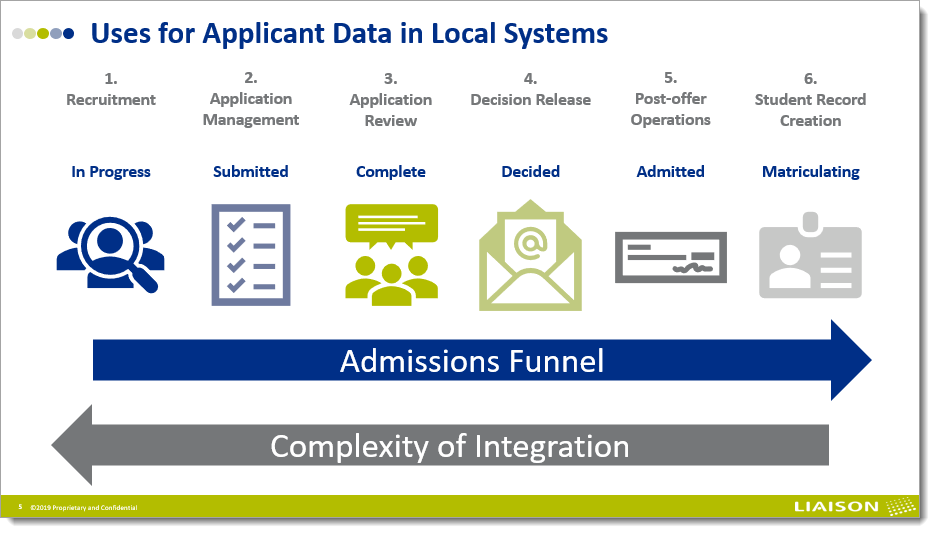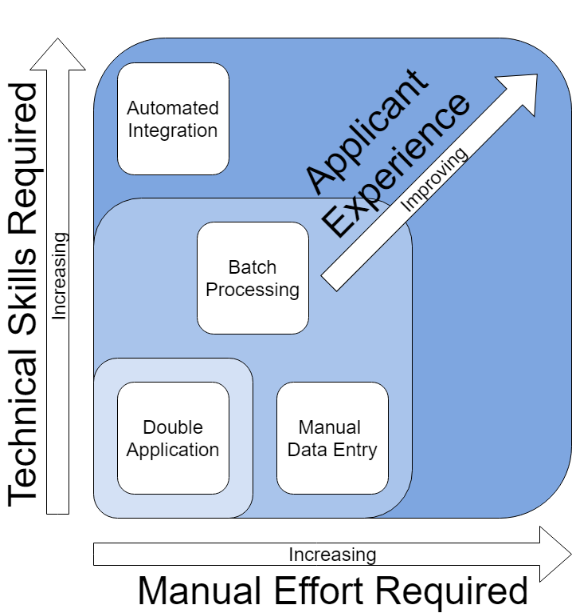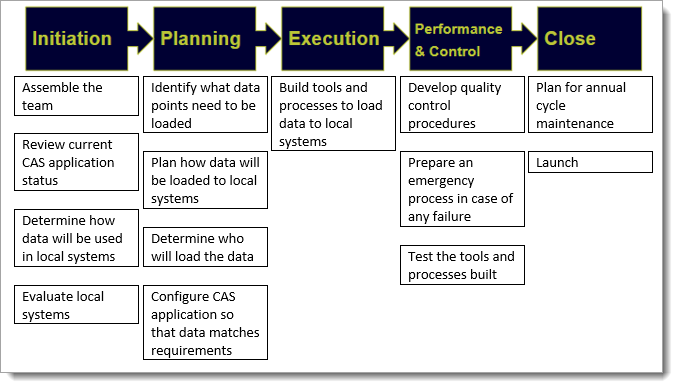Planning for Data Integration
Importing CAS Applications in Local Systems
You must first understand your admissions process to effectively map your data integration project. Review the key features of your admissions process below to better prepare for an integration project.

Using CAS Application Data After Loading It Locally
Institutions use CAS application data in their local systems for six purposes. The following list presents these purposes in the order of an admissions funnel.

- Recruitment: encouraging prospects to apply.
- Application management: encouraging applicants to complete their applications.
- Application review: reviewing completed applications for admission to your program.
- Decision release: notifying applicants of admission decisions.
- Post-offer operations: collecting necessary paperwork and fees from matriculating students.
- Student record creation: creating official digital records for matriculating students.
How Your Intended Use of Data Affects Your Integration
Different uses for CAS application data in local systems have different requirements. To perform early-admissions funnel operations like application management and application review in local systems, you must bring many different data points from CAS and bring them frequently.
Decision release requires somewhat fewer data points (enough to create person and application records and indicate the decision), but if decisions are released on a rolling basis, the data would need to be loaded to local systems frequently.
High frequency data transfers covering many data points are hard to handle with approaches that don't involve data integration, since they require a great deal of time-consuming manual work by admissions staff.
If you want to perform application management, application review, or decision release functions in local systems, it's best to go with Batch Processing or Automated Integration.
If you’re going to review applications and release decisions in Liaison’s platforms, and you only want to perform post-offer operations (e.g., collecting matriculation deposits) or student record creation for matriculating students in local systems, then the slower, labor-intensive processes are fine. These approaches that don't involve data integration have the added benefit of requiring little initial planning and effort to implement. With a lower initial investment required, you can start accepting applications sooner.
Approaches to Integrating Your Data
There are four approaches to getting CAS applications into local systems:
- Double Application: the applicant fills out two applications: one in the CAS and another in your local platform. This places the burden of getting CAS applications into local systems entirely on the applicant, but it frees your admissions team to focus on shaping the entering class.

- Manual Data Entry: your institution manually enters application data into local systems. This method requires a lot of manual effort from staff at your institution and is error-prone, but it saves applicants from duplicating their efforts.

- Batch Processing: your institution retrieves application data in batches from the CAS and loads it to local systems. This process requires some technical skills and elevated access to local systems, but it calls for much less manual effort from staff at your institution and is largely free from errors.

- Automated Integration: your institution builds an automated process that regularly retrieves and loads batches of CAS application data to local systems. This requires significant technical skills and tools, but it accurately and reliably loads CAS application data into your local systems without any manual effort.

Choosing the Best Approach for Your Program

When deciding which approach is best for you, consider the resources available and the desired applicant experience.
Additionally, consider how much time there is to implement one of these approaches before applications start arriving. If your institution has been using a CAS for some time, consider how changing your data integration plan might impact existing applicants.
Finally, it is important to understand how your program intends to use CAS application data in your local systems. If you want to perform early-admissions funnel operations in your local systems, you’ll need to load CAS application data quickly and frequently. This calls for a data integration approach (Batch Processing or Automated Integration). If most admissions funnel operations will be performed in Liaison’s platforms, the other two options will suffice.
Changing Your Current Application Loading Process
You can always change your method of loading CAS application data to your local system. A natural time for switching to a new approach is between cycles. In many cases, the way CAS data is loaded to your local system has little bearing on the way your admissions business processes are done. For instance, if you perform application review in Liaison’s platform and manually create accepted applicants in your local system through data entry, switching to batch processing (downloading and uploading batches of applicant data) won't call for a change in the way application review is performed; it only eliminates the manual effort of data entry to create records in your local system.
Considering Your Options If This Is Your First Cycle Using CAS
If you're using a CAS for the first time, you can still implement whichever approach makes the most sense for your program. Keep your CAS application launch date in mind. If you don’t have much time before applications start arriving, you may want to choose one of the non-integration options that require less time to set up. If you’re not planning on loading CAS application data to local systems until very late in the cycle, then you’ll have more time to figure out how you’ll get the data into local systems.
Determining Who Is Responsible for Getting CAS Application Data into Local Systems
Each institution is organized differently. The way your institution is organized will largely determine which offices are responsible for each function. Some institutions have decentralized admissions offices for each school or college but store all student data in a single SIS. Others have a central admissions office, but the schools and colleges make admissions decisions. Some institutions have operations units skilled at data entry in local systems dedicated to serving admissions’ needs. Others have admissions officers perform all data entry in local systems. Some institutions have business analysts to support admissions offices in using enterprise software. Others keep IT separate from admissions to enable the office to prioritize projects at the institution level.
Consider the stakeholders in admissions process when determining which offices to involve: applicants, the admissions office or offices, the registrar’s office, the financial aid office, and the individual schools or colleges whose applicants are moving through the CAS application. The goal should be for applicants to have a top-notch experience. If the registrar’s office usually handles the creation of student records and transfer credit evaluation, moving transcripts from CAS to local systems might be an appropriate task. If the financial aid office needs certain data in local systems to be able to package applicants prior to decision release, it might be best for the admissions office to get that data loaded for them.
Making Sure CAS Application Data Is Moving Correctly into Local Systems
No matter which approach you take, it's important to establish a robust quality control program to ensure that applicants have a top-notch experience that is seamless from the first interest in the program to the first day in class. If the data in local systems doesn’t accurately represent CAS application data, then applicants might fall through the cracks, sabotaging their student experience before it’s even begun.
Getting Started
Whatever approach you choose, preparing to bring CAS application data into local systems can be approached as a 5-phase project.

